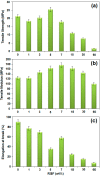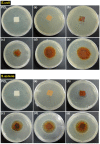Studies on properties of rice straw/polymer nanocomposites based on polycaprolactone and Fe₃O₄ nanoparticles and evaluation of antibacterial activity
- PMID: 25318051
- PMCID: PMC4227226
- DOI: 10.3390/ijms151018466
Studies on properties of rice straw/polymer nanocomposites based on polycaprolactone and Fe₃O₄ nanoparticles and evaluation of antibacterial activity
Abstract
Modified rice straw/Fe3O4/polycaprolactone nanocomposites (ORS/Fe3O4/ PCL-NCs) have been prepared for the first time using a solution casting method. The RS/Fe3O4-NCs were modified with octadecylamine (ODA) as an organic modifier. The prepared NCs were characterized by using X-ray powder diffraction (XRD), Scanning electron microscopy (SEM), Transmission electron microscopy (TEM), Thermogravimetric analysis (TGA) and Fourier transform infrared spectroscopy (FT-IR). The XRD results showed that as the intensity of the peaks decreased with the increase of ORS/Fe3O4-NCs content in comparison with PCL peaks, the Fe3O4-NPs peaks increased from 1.0 to 60.0 wt. %. The TEM and SEM results showed a good dispersion of ORS/Fe3O4-NCs in the PCL matrix and the spherical shape of the NPs. The TGA analysis indicated thermal stability of ORS/Fe3O4-NCs increased after incorporation with PCL but the thermal stability of ORS/Fe3O4/PCL-NCs decreased with the increase of ORS/Fe3O4-NCs content. Tensile strength was improved with the addition of 5.0 wt. % of ORS/Fe3O4-NCs. The antibacterial activities of the ORS/Fe3O4/PCL-NC films were examined against Gram-negative bacteria (Escherichia coli) and Gram-positive bacteria (Staphylococcus aureus) by diffusion method using nutrient agar. The results indicated that ORS/Fe3O4/PCL-NC films possessed a strong antibacterial activity with the increase in the percentage of ORS/Fe3O4-NCs in the PCL.
Figures











Similar articles
-
Synthesis of ZnO/Fe3O4/rGO nanocomposites and evaluation of antibacterial activities towards E. coli and S. aureus.IET Nanobiotechnol. 2019 Sep;13(7):682-687. doi: 10.1049/iet-nbt.2018.5330. IET Nanobiotechnol. 2019. PMID: 31573536 Free PMC article.
-
Curcumin-loaded electrospun polycaprolactone/montmorillonite nanocomposite: wound dressing application with anti-bacterial and low cell toxicity properties.J Biomater Sci Polym Ed. 2020 Feb;31(2):169-187. doi: 10.1080/09205063.2019.1680928. Epub 2019 Oct 30. J Biomater Sci Polym Ed. 2020. PMID: 31609684
-
Synthesis and characterization of rice straw/Fe3O4 nanocomposites by a quick precipitation method.Molecules. 2013 Jun 5;18(6):6597-607. doi: 10.3390/molecules18066597. Molecules. 2013. PMID: 23739066 Free PMC article.
-
Modification of Fe3O4 magnetic nanoparticles for antibiotic detection.Sci Rep. 2025 Feb 8;15(1):4751. doi: 10.1038/s41598-025-87901-z. Sci Rep. 2025. PMID: 39922898 Free PMC article. Review.
-
Antibacterial magnetic nanoparticles for therapeutics: a review.IET Nanobiotechnol. 2019 Oct;13(8):786-799. doi: 10.1049/iet-nbt.2019.0146. IET Nanobiotechnol. 2019. PMID: 31625518 Free PMC article. Review.
Cited by
-
Graphene Family Nanomaterials in Ocular Applications: Physicochemical Properties and Toxicity.Chem Res Toxicol. 2021 Jun 21;34(6):1386-1402. doi: 10.1021/acs.chemrestox.0c00340. Epub 2021 May 27. Chem Res Toxicol. 2021. PMID: 34041903 Free PMC article. Review.
-
Role of bioactive magnetic nanoparticles in the prevention of wound pathogenic biofilm formation using smart nanocomposites.J Nanobiotechnology. 2023 May 21;21(1):161. doi: 10.1186/s12951-023-01905-3. J Nanobiotechnology. 2023. PMID: 37211593 Free PMC article.
-
Synthesis, physicochemical characterisation and biological activity of anandamide/ɛ-polycaprolactone nanoparticles obtained by electrospraying.IET Nanobiotechnol. 2020 Feb;14(1):86-93. doi: 10.1049/iet-nbt.2019.0108. IET Nanobiotechnol. 2020. PMID: 31935683 Free PMC article.
-
New applied pharmacological approach/trend on utilization of agro-industrial wastes.Environ Sci Pollut Res Int. 2018 Sep;25(26):26446-26460. doi: 10.1007/s11356-018-2631-9. Epub 2018 Jul 9. Environ Sci Pollut Res Int. 2018. PMID: 29987463
-
PCL/Col I-based magnetic nanocomposite scaffold provides an osteoinductive environment for ADSCs in osteogenic cues-free media conditions.Stem Cell Res Ther. 2022 Apr 4;13(1):143. doi: 10.1186/s13287-022-02816-0. Stem Cell Res Ther. 2022. PMID: 35379318 Free PMC article.
References
-
- Zhao Q., Tao J., Yam R.C.M., Mok A.C.K., Li R.K.Y., Song C. Biodegradation behavior of polycaprolactone/rice husk ecocomposites in simulated soil medium. Polym. Degrad. Stab. 2008;93:1571–1576. doi: 10.1016/j.polymdegradstab.2008.05.002. - DOI
-
- García M., Garmendia I., García J. Influence of natural fiber type in eco-composites. J. Appl. Polym. Sci. 2008;107:2994–3004. doi: 10.1002/app.27519. - DOI
-
- Wu C.-S., Liao H.-T. Polycaprolactone-Based Green Renewable Ecocomposites Made from Rice Straw Fiber: Characterization and Assessment of Mechanical and Thermal Properties. Ind. Eng. Chem. Res. 2012;51:3329–3337. doi: 10.1021/ie202002p. - DOI
-
- Mohanty A.K., Misra M., Drzal L.T. Sustainable Bio-Composites from Renewable Resources: Opportunities and Challenges in the Green Materials World. J. Polym. Environ. 2002;10:19–26. doi: 10.1023/A:1021013921916. - DOI
Publication types
MeSH terms
Substances
LinkOut - more resources
Full Text Sources
Other Literature Sources
Medical

